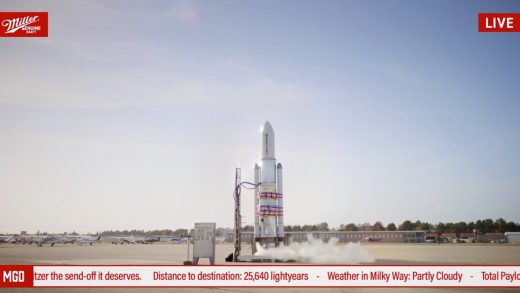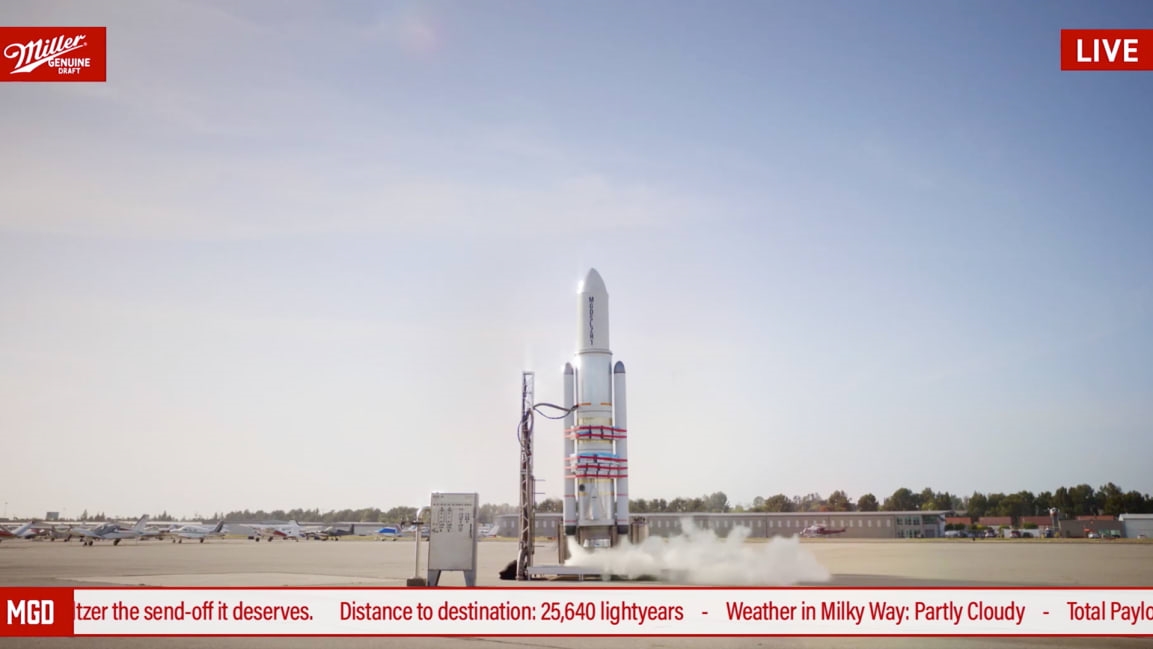Miller Genuine Draft and the black hole of space advertising
This week Miller Genuine Draft aimed to be the latest brand to launch a seltzer. Just not the brand extension product you can buy at a store. No, Miller was going to launch a seltzer into space.
The brand had spent the preceding days hyping its stunt of launching a hard seltzer—beer’s latest trendy rival—as a gesture of hostility toward yet another tasteless carbonated beverage in a can. Miller has seen the proliferation of hard seltzer, like so many boozy bunny rabbits, increasingly take shelf space and cultural real estate from the original suds. Perhaps the bulk of its disdain is saved for beer brands that have jumped on the clear bevvie bandwagon such as Michelob Ultra, Bud Light, Corona, and Pabst Blue Ribbon.
T-minus 45 minutes until MGD launches a hard seltzer. Into oblivion. Tune into @MillerLite‘s page to watch it all go down! pic.twitter.com/nGUTycScvx
— Molson Coors Beverage Company (@MolsonCoors) May 13, 2021
This was going to be the “beer’s beer” brand’s own little “Stratos” moment. A live broadcast across social media of an elaborately expensive and ultimately pointless stunt.
“We brew beer, it’s what we do, it’s what we love,” says the spokesman. “But then so many other brands started hopping on that bandwagon, then all of a sudden there came this overwhelming expectation for us to do the same.”
It wouldn’t have to look far for that expectation. Miller parent company Molson Coors has been more than happy to jump on the trend, with hard seltzers such as Vizzy and Coors Seltzer. Sofia Colucci, VP of the Miller Family of Brands, told AdAge, “This program is really meant to reinforce the role of one of our key brand portfolios—the Miller Family—and that we’re a beer’s beer. The only seltzer launch we’re planning is this launch into oblivion, so yes, Miller will remain dedicated to beer and beer only.”
Live at 4pm EST. Seltzer gets the launch it deserves ????. https://t.co/yMNtBbmqaO
— Miller Lite (@MillerLite) May 13, 2021
When it finally came time to follow through on this elaborate gimmick, though, the brand blinked. There was no real launch. The rocket exploded before taking off. All fizz, no buzz. Turns out, at 4 p.m. ET on May 13, what Miller Genuine Draft actually did was simply press play on what amounted to an eight-minute spoof of these commercial events, ostensibly doubling up on irony. It first spoofed brands that launch things into space with the prospect of launching somebody else’s product into space, then turned it into a pretty standard—if excruciatingly long—beer commercial.
We’ve come a long way from the common sense of Miller High Life Delivery Guy.
What marketers want to believe is that each new space-related stunt is their own giant leap for brand-kind, whereas in practice too often it’s simply the final frontier for a lack of any other decent ideas. If you can’t think of anything to say about your brand, threaten to launch it into space. People just can’t help being interested in a company paying millions to take all the science, research, and technology that has been harnessed in order for us, as a human race, to expand beyond our pale blue dot and into the great beyond of the cosmos . . . and use it to sell us junk food.
Back in 1984, NASA put both a Coke and a Pepsi can on the space shuttle as an experiment. In 1996, Coke had a custom-made soda dispenser on the shuttle Endeavor, while Pepsi reportedly paid the Russian space agency $5 million to have a cosmonaut hold a replica can during a space walk. Pizza Hut paid about $1 million in 1999 to have its logo slapped on the side of a Russian Proton rocket launched to the International Space Station. In 2017, KFC sent a Chicken Zinger sandwich to the stratosphere.
The next year, it was Elon Musk’s turn, launching a Tesla Roadster into orbit driven by a mannequin named Starman. Of course, this one was a twofer, acting as a clever brand play for both Tesla and SpaceX.
Goodbye, Earth! pic.twitter.com/8PZh7SNyUH
— Starman (@SpaceX_Starman) February 7, 2018
Humankind’s obsession with space is complex. It’s not just about science—it’s also spiritual. Are we alone? What is our purpose? What would a chicken sandwich look like in orbit?
Miller Genuine Draft is toying with this idea, while also becoming a part of the brands-in-space industrial complex itself. Much more of this, and it won’t be long before the space gimmick is no longer full of commercial wonder, if it hasn’t been completely deflated beyond a brief smirk of interest on social already.
In 1967, the world agreed that space should not be militarized. Time to extend that treaty to the Cola Wars, the beer-seltzer conflict, and every other ad fight.
(37)



